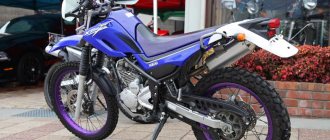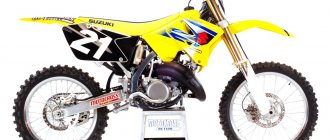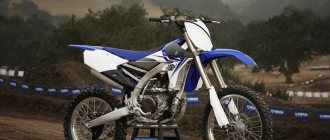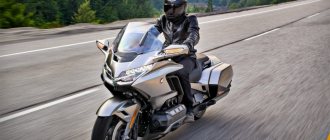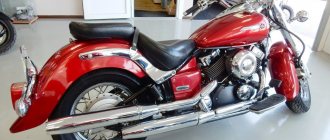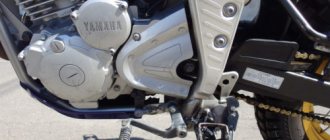- motorcycle model, Yamaha brand
The soft-enduro model Yamaha XT225 Serow begins its history in 1985 - it was then that a motorcycle called Yamaha Serow (factory designation XT225W) appeared on the domestic Japanese market. The model was distinguished by simple equipment - a 1-cylinder 2-valve air-cooled engine, simple long-travel suspensions, a steel frame, a rear drum brake, a 7.6-liter fuel tank and a kick starter.
By the way, the prefix Serow was used only on domestic Japanese motorcycles, and meant “Serow” or “Serow” - a genus of artiodactyl mammals from the bovid family, average in size between a deer and a goat, living in the mountains of Japan, China, India and some other areas of Southeast Asia . The concept of the motorcycle, as conceived by Yamaha, precisely reflected the character and endurance of this animal, capable of covering long distances along forest paths in mountainous terrain.
In 1989, the Yamaha XT225W Serow received minor changes, receiving minor visual differences, an electric starter and a larger fuel tank (7.6 → 8.8 l). Since 1992, this generation begins to be officially sold in foreign markets - in particular in Europe and North America. Export modifications do not have the letter W in the name (Japanese versions are always designated as XT225W or XT225WE) and the Serow prefix. Also, the export versions did not undergo the changes that affected the internal Japanese modifications.
In 1993, the Japanese version of the Yamaha XT225W Serow again undergoes changes, receiving a rear disc brake (factory designation for this generation is 4JG). In 1995, Yamaha offered a commemorative version of the Yamaha XT225W Serow Limited Edition in honor of the 10th anniversary of the model's production.
In 1997, the Yamaha XT225W Serow undergoes another change, receiving a larger fuel tank (8.8 → 10 l) and tubeless tires. Also, starting this year, domestic Japanese versions receive the letter E in the name - Yamaha XT225WE Serow.
The last change to the Japanese model was made in 2000, when the Serow received exhaust changes and an afterburner system to meet new environmental requirements. This generation, unchanged, was produced until 2004 inclusive.
The export version of the Yamaha XT225 existed until 2007 inclusive, after which the XT225 series was replaced by a new one - the Yamaha Serow XT250. Export modifications of the Yamaha XT225 are essentially the domestic Japanese Yamaha XT225W Serow of the second generation (1989-1993, factory code - 3RW) without significant changes.
The following models were built based on the engine from the XT225: Yamaha ST225 Bronco and Yamaha TW225.
Bike features
Here are the main advantages of the model:
- excellent adaptability to driving on mountain slopes;
- significant traction;
- comfortable but low rise;
- minimalism in everything.
The last point, by the way, may confuse some at first, since that is why the motorcycle looks somewhat tasteless. It’s just that the designers prioritized practicality rather than aesthetics. If you remember this, no questions will arise for the bike.
Brief history of the model
1985 - start of production and sales. First generation. Model: Yamaha XT225W Serow (Japan). Factory designation: 1KH.
1986 - no significant changes. Model: Yamaha XT225W Serow (Japan). Factory designation: 1RF0.
1987 - no significant changes. Model: Yamaha XT225W Serow (Japan). Factory designation: 2LN0.
1989 - restyling of the model. Second generation. Model: Yamaha XT225W Serow (Japan). Factory designation: 3RW1.
1991 - no significant changes. Model: Yamaha XT225W Serow (Japan). Factory designation: 3RW2.
1992 - no significant changes. The model becomes available in foreign markets. Model: Yamaha XT225W Serow; Yamaha XT225D (Japan; Europe, North America). Factory designation: 3RW3, 3RW4; 4BE3.
1993 - restyling of the domestic Japanese model. Third generation. Model: Yamaha XT225W Serow; Yamaha XT225E (Japan; Europe, North America). Factory designation: 3RW5, 4JG1; 4BE6.
1994 - no significant changes. Model: Yamaha XT225F (Europe, North America). Factory designation: 4BE9.
1995 - no significant changes. Model: Yamaha XT225W Serow; Yamaha XT225G (Japan; Europe, North America). Factory designation: 4JG2, 4JG3; 4BEC.
1996 - no significant changes. Model: Yamaha XT225W Serow; Yamaha XT225H (Japan; Europe, North America). Factory designation: 4JG4; 4BEF.
1997 - restyling of the domestic Japanese version. Fourth generation. Model: Yamaha XT225WE Serow; Yamaha XT225J (Japan; Europe, North America). Factory designation: 4JG5; 4BEJ.
1998 - no significant changes. Model: Yamaha XT225WE Serow; Yamaha XT225K (Japan; Europe, North America). Factory designation: 4JG6; 4BEM.
1999 - no significant changes. Model: Yamaha XT225L (Europe, North America). Factory designation: 4BER.
2000 - restyling of the domestic Japanese version. Fifth generation. Model: Yamaha XT225WE Serow; Yamaha XT225M (Japan; Europe, North America). Factory designation: 5MP1; 4BEU.
2001 - no significant changes. Model: Yamaha XT225N (Europe, North America). Factory designation: 4BEW (California), 4BEV (USA), 4BEX (Europe).
2002 - no significant changes. Model: Yamaha XT225WE Serow; Yamaha XT225P (Japan; Europe, North America). Factory designation: 5MP2; 4BEY (USA), 5RK1 (California), 5RK2 (Europe).
2003 - no significant changes. Model: Yamaha XT225WE Serow; Yamaha XT225R (Japan; Europe, North America). Factory designation: 5MP3; 5RK3 (USA), 5RK4 (California), 5RK5 (Europe).
2004 is the last year of production of the domestic Japanese version. Model: Yamaha XT225WE Serow; Yamaha XT225S (Japan; Europe, North America). Factory designation: 5MP4; 5RK6 (USA), 5RK7 (California), 5RK8 (Europe).
2005 - no significant changes. Model: Yamaha XT225T (Europe, North America). Factory designation: 5RK9 (USA), 5RKA (California), 5RKB (Europe).
2006 - no significant changes. Model: Yamaha XT225V (Europe, North America). Factory designation: 5RKC (USA), 5RKD (California), 5RKE (Europe).
2007 is the last year of production of export versions. Model: Yamaha XT225W (Europe, North America). Factory designation: 5RKF (USA), 5RKG (California), 5RKH (Europe).
Dimensions and weight
Without fuel, the XT 225 Serow weighs 108 kg, which is very light even for a small off-road motorcycle. A tank volume of 9.8 liters is quite sufficient, since the average gasoline consumption per hundred kilometers for this model is approximately 3 liters. The motorcycle's seat height is 810 mm, its length is 2070 mm, its width is 805 mm, and its overall height is 1161 mm.
Yamaha Serow 250 review
The foundation around which the entire motorcycle is built is the frame, encased in steel and plastic. The light, attractive and moderately aggressive design has won the hearts of a huge number of motorcyclists, ensuring the Yamaha Serow 250 enormous popularity. Designers from the world-famous Italian studio Pininfarina worked on the appearance of the enduro, who managed to breathe into it a drop of bright interest and their own zest, which makes the car stand out among its analogues.
The model is available in two versions - motard and enduro, differing only in suspension settings and wheels. The motorcycles are created on the same basis - a steel frame, a carburetor, a 249 cubic centimeter engine, an air cooling system and a chain drive. The transmission is a five-speed and is quite loud, as is typical of most air-cooled Yamahas. At the same time, the gearbox is very reliable and has clear gear shifting.
At 6500 rpm both maximum torque and maximum power are achieved, which is quite interesting, unusual and serves as excellent proof that the bike maintains its dynamics at peak power. The Yamaha Serow 250 not only starts off briskly, but also accelerates at full speed, leaving many of its classmates behind in these parameters. The engine power - 21 horsepower - is more than enough for such behavior, especially considering the fact that the curb weight of the bike is a maximum of 120 kilograms, depending on the model year.
One of the most important characteristics of an off-road enduro is its suspension, represented by a 35 mm telescopic fork at the front and a monoshock absorber with preload adjustment at the rear. Of course, the Serow is not designed for high jumps, but the bike can handle a slalom through a windfall forest or a long race.
The lightweight design provides excellent handling and excellent power efficiency. Of course, you can find more powerful enduro models, but the compact Yamaha Serow 250 is capable of giving a head start to many of its competitors.
Chassis and brakes
The frame of this model is made of steel. It may seem dull to some, but there is simply nothing superfluous about it. The rims are medium in size and spoked in type. The handlebars are typical for an off-road bike and allow you to control it comfortably even on bumpy, rough terrain.
The rear suspension is a pendulum version along with a monoshock absorber. At the front, a telescopic fork serves as this. The rear brake is a 220mm disc assisted by a single-piston caliper. At the front, the XT 225 Serow brakes using a disc of the same diameter, but there is a two-piston caliper.
Modifications
Since at the time of production the model did not have any special competitors in terms of price/quality, they did not engage in any modifications for it.
The Yamaha TW 225 was produced for the domestic market, looked stylish, and was successful even outside of Japan.
But the concept of the model served as a prototype for several other developments of the brand:
- TW 225 . In 2002 it took over from serow. Intended for domestic sales. Thanks to consumer interest, it appeared in markets outside Japan.
- ST 225 Bronco is a scrambler. Enduro is closer to the realities of city riding. It was produced for 2 years, starting in 1997. It had a redesigned gearbox for more convenient trips around the city.
- XT 225 . Under this name the basic model was offered for the US markets. Apart from the name and external color (more cremated), there were no differences.
In 2005, Serow received a second life. With minor modifications, a model with a 250 cc engine - Serow 250 - is put on the conveyor.
Engine
The Yamaha XT 250 is powered by a single-cylinder, four-stroke engine with a displacement of 249 cubic centimeters, a peak power of 21 horsepower and a maximum torque of 20.5 Nm. The chassis, like the power unit, is almost completely borrowed from the previous generation - Serow 225 - and is represented by a front telescopic fork and a rear adjustable monoshock absorber. The most serious changes made to the technical component of the motorcycle were the introduction of an electric starter and the elimination of the kick starter. Since 2007, it began to be equipped with an injection power system, which replaced the carburetor.
Historical reference
Yamaha Serow 225 has undergone the following modernization during its release:
- in the first generation (1985-1987) - rear wheel brake of the “drum” type;
- the second, from 1988 to 1995, had external improvements;
- in the final seven years of the third generation, the braking system changed (discs appeared), the gas tank increased from 8.7 to 9.8 liters, and some improvements to the body design and plastic took place.
It is interesting that from the moment of its formation the company specialized in the production of musical instruments. That is why the emblem contains 3 crossed tuning forks. The founder of Thorakusu Yamaha purchased a German motorcycle for himself. And I was so impressed with it that I decided to release an exact copy.
So, in 1955, Yamaha Motor Co. appeared. Thanks to this event, thousands of motorcycles ride around the world. The famous company Pininfarina (Italy) was involved in the development of the appearance of the Serow.
By the way, serow means “Japanese mountain goat”. This animal does not develop great speed, but it climbs hills well. This perfectly characterizes the model of the same name.

